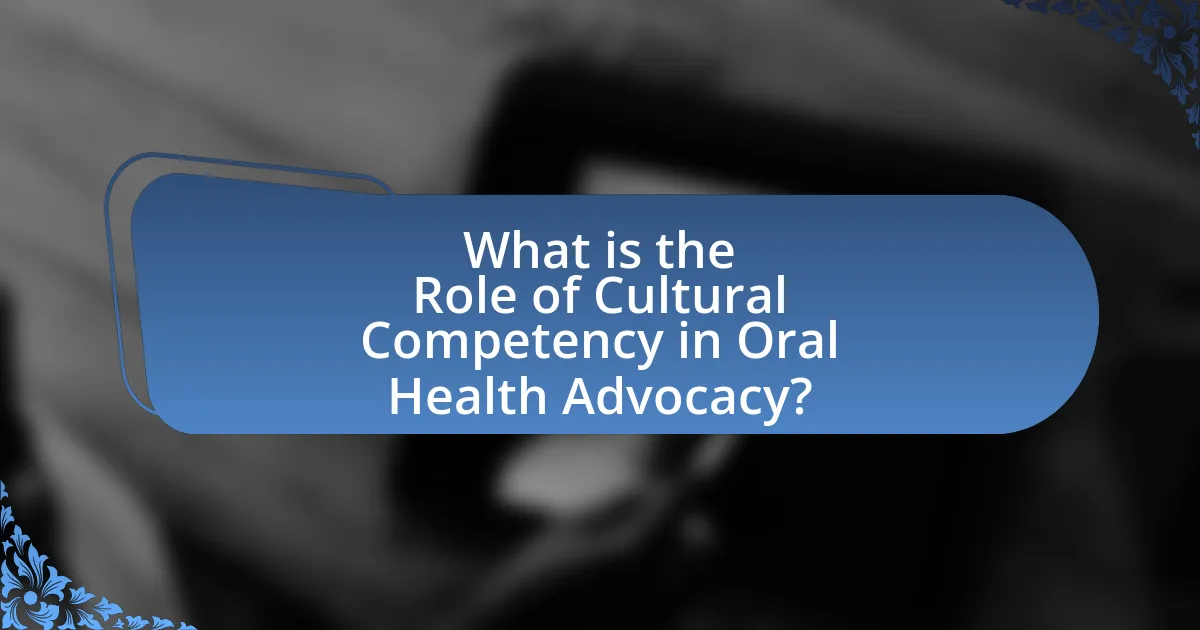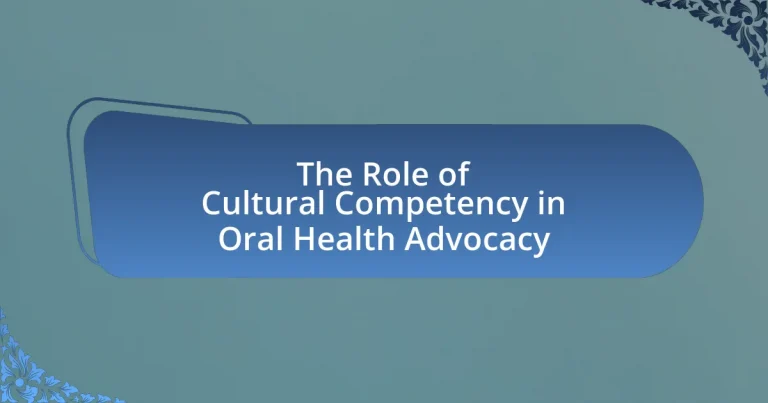Cultural competency is a vital aspect of oral health advocacy, as it ensures that healthcare providers recognize and respect the diverse cultural backgrounds of their patients, leading to improved communication, trust, and health outcomes. The article explores how cultural competency influences oral health outcomes, identifies key components necessary for effective patient-provider communication, and highlights the disparities in oral health access among different cultural groups. It also addresses the challenges in implementing cultural competency within healthcare systems and offers practical steps for oral health advocates to enhance their cultural awareness and engagement with diverse communities. By fostering partnerships and incorporating community feedback, oral health initiatives can become more effective and equitable, ultimately reducing health disparities.

What is the Role of Cultural Competency in Oral Health Advocacy?
Cultural competency plays a crucial role in oral health advocacy by ensuring that healthcare providers understand and respect diverse cultural backgrounds, which enhances patient communication and trust. This understanding leads to improved health outcomes, as culturally competent care addresses specific beliefs, practices, and needs related to oral health within different communities. Research indicates that culturally tailored interventions can significantly increase patient engagement and adherence to treatment plans, ultimately reducing health disparities in oral health access and outcomes. For instance, a study published in the Journal of Dental Research found that culturally competent care improved patient satisfaction and treatment compliance among minority populations.
How does cultural competency influence oral health outcomes?
Cultural competency significantly influences oral health outcomes by enhancing communication and trust between healthcare providers and patients from diverse backgrounds. When dental professionals understand and respect cultural differences, they can tailor their approaches to meet the specific needs of patients, leading to increased patient satisfaction and adherence to treatment plans. Research indicates that culturally competent care can reduce disparities in oral health access and outcomes, as evidenced by a study published in the Journal of Dental Research, which found that patients who perceived their providers as culturally competent were more likely to seek preventive care and follow through with recommended treatments.
What are the key components of cultural competency in healthcare?
The key components of cultural competency in healthcare include awareness of cultural differences, knowledge of diverse health beliefs and practices, effective communication skills, and the ability to adapt care to meet the cultural needs of patients. Awareness involves recognizing one’s own cultural biases and understanding how these can affect patient interactions. Knowledge encompasses understanding various cultural health practices and beliefs, which can influence patient care and treatment adherence. Effective communication skills are essential for building trust and ensuring that patients feel understood and respected. Finally, the ability to adapt care means tailoring healthcare practices to align with the cultural values and preferences of patients, which has been shown to improve health outcomes and patient satisfaction.
How does cultural competency affect patient-provider communication?
Cultural competency significantly enhances patient-provider communication by fostering mutual understanding and respect between healthcare professionals and patients from diverse backgrounds. When providers are culturally competent, they are better equipped to recognize and address the unique cultural beliefs, values, and practices that influence a patient’s health behaviors and perceptions. This understanding leads to improved trust, increased patient satisfaction, and better adherence to treatment plans. Research indicates that culturally competent care can reduce health disparities; for instance, a study published in the Journal of Health Care for the Poor and Underserved found that culturally tailored interventions improved communication and health outcomes among minority populations.
Why is cultural competency essential in oral health advocacy?
Cultural competency is essential in oral health advocacy because it enables healthcare providers to effectively communicate and engage with diverse populations. This understanding fosters trust and improves patient outcomes by addressing specific cultural beliefs and practices related to oral health. Research indicates that culturally competent care can reduce health disparities; for instance, a study published in the Journal of Health Care for the Poor and Underserved found that culturally tailored interventions significantly improved oral health knowledge and behaviors among minority groups. Thus, cultural competency directly contributes to more equitable and effective oral health advocacy efforts.
What disparities exist in oral health among different cultural groups?
Disparities in oral health among different cultural groups include variations in access to dental care, prevalence of oral diseases, and attitudes towards oral health. For instance, studies show that racial and ethnic minorities, such as African Americans and Hispanics, often experience higher rates of untreated dental caries and periodontal disease compared to their white counterparts. According to the National Institute of Dental and Craniofacial Research, these groups face barriers such as socioeconomic factors, lack of insurance, and cultural beliefs that influence their utilization of dental services. Additionally, language barriers and mistrust of healthcare providers can further exacerbate these disparities, leading to poorer oral health outcomes in these populations.
How can cultural competency reduce these disparities?
Cultural competency can reduce disparities in oral health by enabling healthcare providers to understand and effectively respond to the diverse cultural needs of patients. This understanding fosters trust and improves communication, leading to better patient engagement and adherence to treatment plans. Research indicates that culturally competent care can enhance health outcomes; for instance, a study published in the Journal of Health Care for the Poor and Underserved found that culturally tailored interventions significantly improved oral health knowledge and behaviors among minority populations. By addressing cultural barriers, healthcare systems can ensure equitable access to oral health services, ultimately reducing disparities in health outcomes.
What are the challenges in implementing cultural competency in oral health advocacy?
Implementing cultural competency in oral health advocacy faces several challenges, including a lack of standardized training, insufficient understanding of diverse cultural practices, and systemic barriers within healthcare systems. The absence of uniform training programs means that oral health advocates may not receive adequate education on cultural nuances, leading to ineffective communication and care. Additionally, many healthcare providers may not fully understand the cultural beliefs and practices of the populations they serve, which can result in misinterpretations and a lack of trust. Systemic barriers, such as limited access to resources and funding for culturally competent programs, further hinder the ability to effectively advocate for diverse communities. These challenges collectively impede the goal of providing equitable oral health care to all populations.
What barriers do healthcare providers face in becoming culturally competent?
Healthcare providers face several barriers in becoming culturally competent, including lack of training, insufficient resources, and personal biases. Lack of training often results from inadequate educational curricula that do not emphasize cultural competency, leading to healthcare professionals feeling unprepared to address diverse patient needs. Insufficient resources, such as access to interpreters or culturally relevant materials, further complicate the ability to provide effective care. Additionally, personal biases can hinder providers from fully understanding and respecting the cultural backgrounds of their patients, which can negatively impact patient-provider relationships and health outcomes. Studies indicate that these barriers contribute to disparities in healthcare access and quality among different cultural groups.
How can these challenges be addressed effectively?
To address challenges in oral health advocacy effectively, implementing cultural competency training for healthcare providers is essential. This training equips providers with the skills to understand and respect diverse cultural backgrounds, which enhances communication and trust with patients. Research indicates that culturally competent care leads to improved patient outcomes and satisfaction, as evidenced by a study published in the Journal of Health Care for the Poor and Underserved, which found that culturally tailored interventions significantly increased engagement in preventive dental care among minority populations. Additionally, fostering partnerships with community organizations can help bridge gaps in access to care and ensure that advocacy efforts are aligned with the specific needs of diverse communities.
How can cultural competency be integrated into oral health advocacy programs?
Cultural competency can be integrated into oral health advocacy programs by incorporating training that emphasizes understanding diverse cultural beliefs, practices, and values related to oral health. This training should include the development of communication strategies that are respectful and relevant to various cultural groups, ensuring that oral health messages resonate with different populations. Research indicates that culturally tailored interventions can improve health outcomes; for instance, a study published in the Journal of Public Health Dentistry found that culturally competent care significantly increased patient satisfaction and adherence to treatment plans among minority populations. By actively engaging community leaders and stakeholders in the design and implementation of these programs, oral health advocates can ensure that the initiatives are culturally relevant and effectively address the unique needs of the communities they serve.
What training methods are effective for enhancing cultural competency among oral health professionals?
Effective training methods for enhancing cultural competency among oral health professionals include experiential learning, workshops, and simulation-based training. Experiential learning allows professionals to engage directly with diverse communities, fostering understanding through real-world interactions. Workshops often incorporate case studies and role-playing scenarios, which help participants navigate cultural differences in patient care. Simulation-based training, utilizing virtual reality or standardized patients, provides a safe environment for practitioners to practice culturally sensitive communication and decision-making. Research indicates that these methods significantly improve cultural awareness and skills, leading to better patient outcomes and satisfaction.
How can community engagement improve cultural competency in oral health initiatives?
Community engagement can improve cultural competency in oral health initiatives by fostering trust and understanding between healthcare providers and diverse populations. Engaging community members allows for the identification of specific cultural beliefs, practices, and barriers related to oral health, which can inform tailored interventions. For instance, a study published in the Journal of Public Health Dentistry found that community-based participatory research led to increased awareness and utilization of dental services among minority groups, demonstrating that culturally informed approaches enhance health outcomes. By actively involving community stakeholders, oral health initiatives can better address the unique needs of various cultural groups, ultimately leading to more effective and equitable care.
What best practices can enhance cultural competency in oral health advocacy?
Best practices that can enhance cultural competency in oral health advocacy include training healthcare providers in cultural awareness, employing diverse staff, and engaging with community leaders. Training healthcare providers in cultural awareness equips them with the skills to understand and respect diverse cultural beliefs and practices, which is essential for effective communication and trust-building. Employing diverse staff reflects the community’s demographics, fostering relatability and understanding among patients. Engaging with community leaders ensures that advocacy efforts are culturally relevant and tailored to the specific needs of the population, thereby increasing the effectiveness of oral health initiatives. These practices are supported by research indicating that culturally competent care improves patient satisfaction and health outcomes.
What role do partnerships with community organizations play in promoting cultural competency?
Partnerships with community organizations play a crucial role in promoting cultural competency by facilitating access to diverse perspectives and resources. These collaborations enable healthcare providers to better understand the cultural, social, and economic factors that influence health behaviors within specific communities. For instance, a study published in the Journal of Health Care for the Poor and Underserved highlights that partnerships with local organizations can lead to tailored health interventions that resonate with community values, ultimately improving health outcomes. By leveraging the expertise and trust that community organizations have within their populations, healthcare systems can enhance their cultural competency and deliver more effective oral health advocacy.
How can feedback from diverse communities shape oral health advocacy efforts?
Feedback from diverse communities can significantly shape oral health advocacy efforts by ensuring that the initiatives are culturally relevant and address specific needs. When advocacy groups actively seek input from various cultural backgrounds, they can identify unique barriers to oral health access, such as language differences, cultural beliefs about dental care, and socioeconomic factors. For instance, a study published in the Journal of Public Health Dentistry found that culturally tailored interventions increased participation in oral health programs among minority populations by 30%. This demonstrates that incorporating community feedback leads to more effective advocacy strategies that resonate with the target audience, ultimately improving oral health outcomes.
What practical steps can oral health advocates take to improve cultural competency?
Oral health advocates can improve cultural competency by implementing targeted training programs that educate dental professionals about diverse cultural practices and beliefs related to oral health. These training programs should include workshops that focus on communication skills, understanding cultural nuances, and addressing health disparities. Research indicates that culturally competent care can lead to better patient outcomes; for instance, a study published in the Journal of Dental Education found that training in cultural competency significantly improved dental students’ interactions with patients from diverse backgrounds. Additionally, advocates can collaborate with community organizations to develop outreach initiatives that engage underrepresented populations, ensuring that oral health resources are accessible and culturally relevant.


